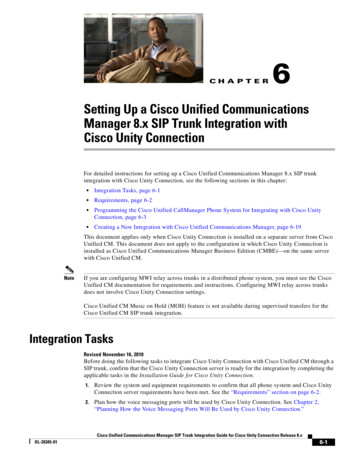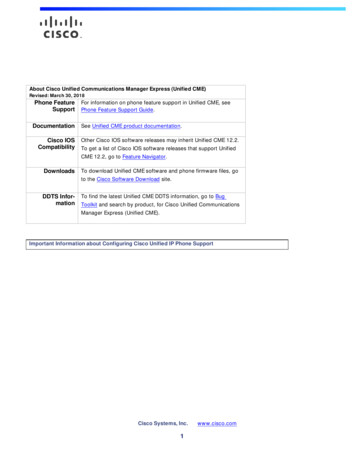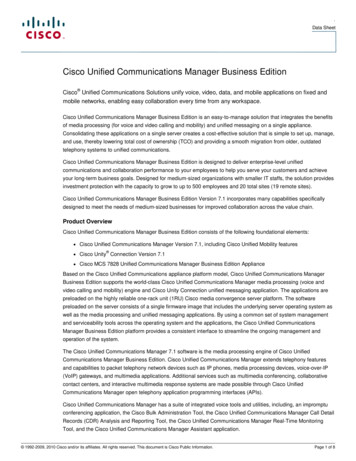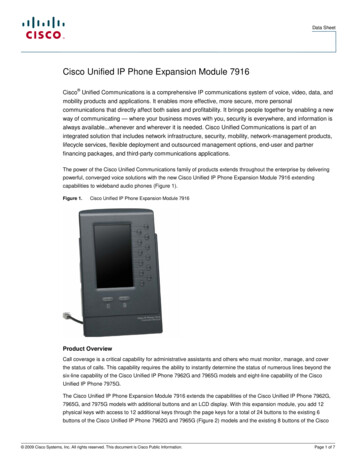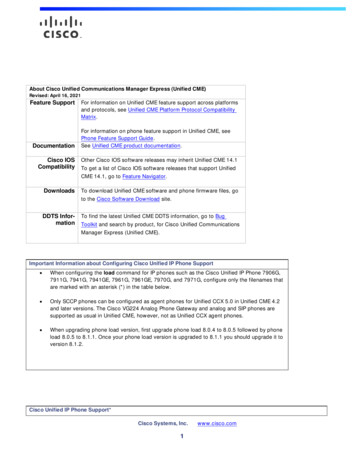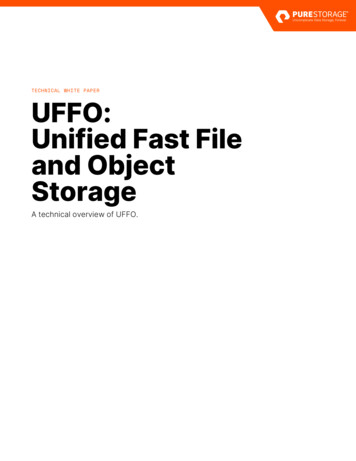
Transcription
TECHNICAL WHITE PAPERUFFO:Unified Fast Fileand ObjectStorageA technical overview of UFFO.
TECHNICAL WHITE PAPERContentsBackground .3What Is UFFO? .3Why Introduce a New Category of Storage? . 3Architecture Matters . 4Requirements for Modern Applications .4Multi-dimensional Performance. 5Why Fast Object Storage? . 5Cloud-ready . 6Dynamic Scalability . 6Intelligent Architecture . 6Always Available . 6Multi-protocol Support . 7What Is Modern Unstructured Data? . 7Use Cases for UFFO .8Pure Storage FlashBlade//S: A UFFO Platform .9Multi-dimensional Performance. 9Cloud-ready . 10Dynamic Scalability . 14FlashBlade//S and Evergreen . 15Intelligent Architecture .15Always Available .16Multi-protocol Support . 17Conclusion . 17Additional Resources . 18Uncomplicate Data Storage, Forever2
TECHNICAL WHITE PAPERBackgroundUnstructured data consists of files, objects, or both. Traditionally, dedicated storage and computeresources were used to store and access unstructured data. Object storage systems were typicallylow-performing and designed for archived data, while file storage systems can be complex andchallenging to scale. The result is an inefficient use of resources with separate storage silos for eachtype of data.Some storage systems provide both file and object storage on the same platform via a front end of either object-protocol-onfile or file-protocol-on-object. In this design, either files or objects are prioritized over the other. Therefore, these gatewaysolutions come at the cost of lower efficiency and performance for either files or objects.Today’s modern applications need to access, analyze, and restore massive amounts of unstructured data at a highperformance level. Although all storage vendors have access to the same commodity hardware components, how the softwaretakes advantage of the hardware is critical to meeting the needs of modern applications. In other words: architecture matters.A unified fast file and object (UFFO) storage platform has independent file and object stores on the back end and nativeprotocols to access the data in each store. NFS and SMB allow for file access, and S3 provides access to object data.What Is UFFO?Modern applications need simplicity, performance, and rich data services at scale. Unified fast file and object (UFFO) is acategory of scale-out, high-performance storage, and it addresses the needs of modern unstructured data and applications.Unified refers to a single physical platform that natively stores both file and object data to consolidate critical workloads,resulting in better utilization of resources and a higher return on investment (ROI.)Fast means exceptionally high throughput and performance regardless of the size of the data sets, the type of I/O pattern(read, write, sequential, random), or the number of files or objects (up to billions.)File access is a defining characteristic of UFFO. The platform must natively support NFS for Linux/Unix clients and SMBfor Windows clients.Object access is required for a UFFO platform and provides clients an S3 protocol interface to store, access, and manageobject data.Why Introduce a New Category of Storage?If you are wondering why the storage industry came up with this new category, the short answer is because modernapplications and their unstructured data require it.Uncomplicate Data Storage, Forever3
TECHNICAL WHITE PAPERLegacy storage doesn’t work well for these applications because it is: Single-purpose and complex with limited scalability Too slow and rigid for modern data and applications Fast but lacks enterprise-ready data services and robust protocol supportFigure 1. Traditional legacy storage platforms lack the flexibility that modern unstructured data needs.Traditional legacy storage platforms were built for structured data and older applications such as databases. But theunstructured file and object data from modern applications require higher performance, rich data services like snapshots andreplication, and scalability. For example, consider the amount of data generated by sensors, real-time video processing,financial services applications, and predictive analysis.Architecture MattersA storage platform can stand out from the others in its performance, scalability, and ease of use. Architecture matters becausea solution that meets these criteria not only depends on the software design itself, but it also depends on how the softwaretakes advantage of the hardware. In this sense, hardware does matter, and a better way to say it is that architecture mattersbecause architecture includes both hardware and software.Requirements for Modern ApplicationsModern applications need scalability, performance, and rich data services. Modern data and applications require: Multi-dimensional high performance Cloud-readiness Dynamic scalability Intelligent architecture High availability Accessibility by both file and object protocolsWe will discuss how the attributes of a UFFO storage platform meet each of these requirements in greater detail below.Uncomplicate Data Storage, Forever4
TECHNICAL WHITE PAPERFigure 2. Modern data requirements.Multi-dimensional PerformanceMulti-dimensional performance is the ability to deliver high performance for multiple concurrent file and object workloads,regardless of the characteristics of the workloads. Workload attributes include: Data size (large or small files or objects) Number of files and objects Sequential or random access Type of operation (read or write) Batch or real-time processesTraditional architectures can deliver high performance for small or large files and sequential or random file workloads. Butmodern data workloads require all the attributes listed above at the same time.A UFFO platform has a core data store and advanced metadata management to natively support file and object protocols andprovide multi-dimensional performance. This architecture is fundamental to its ability to take consolidation to the next level.A UFFO platform delivers scalable, predictable performance with high throughput and can handle tens of billions of files andobjects. From small and metadata-heavy to large streaming files, UFFO delivers performance for any access pattern, randomor sequential, without the need for manual performance tuning.Why Fast Object Storage?Object storage was initially a simple way to store large amounts of archival data at a low cost. But cloud-native applicationsuse object storage for mission-critical data. Modern applications require higher object performance to gain insights from thedata, resulting in faster decisions, reduced time to market, and a competitive edge. The public cloud cannot deliver enoughUncomplicate Data Storage, Forever5
TECHNICAL WHITE PAPERperformance for object data, so many organizations need the ability to run fast object storage on-premises or in a hybrid cloudarchitecture. UFFO architecture should provide higher performance for object data than existing legacy storage platforms.Cloud-readyUFFO platforms must be agile and flexible to meet today’s performance and capacity requirements and be able to seamlesslyadapt as workloads change. There must be different consumption options for the platform, such as subscription services.Modular components and flexible architecture are required so that future expansion and enhancements are simple toimplement, while still maintaining predictable performance and high availability.Cloud strategies often change and evolve. Therefore, a UFFO platform should support the major public cloud providers suchas Amazon and Azure, while also supporting a hybrid cloud model. Most importantly, you should have complete control of theplatform’s operation and security, regardless of its location.Dynamic ScalabilityScalability is often only associated with capacity, but a UFFO platform must seamlessly scale capacity, performance,metadata, and the number of files and objects. Scaling should be simple and non-disruptive to both availability andperformance. When adding more hardware, resources should be immediately available and consumable to the applications.Storage capacity and compute resources should be modular and scale independently to configure systems that optimizeperformance, capacity, and cost effectiveness. When requirements change, a dynamically scalable system is simple toreconfigure.Intelligent ArchitectureUFFO architecture must be “intelligent” in its design to take advantage of the performance and efficiencies of flash media.Intelligence also means that the platform is simple to install, manage, and upgrade, and the platform hides its complexity fromthe end-users.A UFFO platform should not require constant user intervention for performance tuning and load balancing. Ideally, thearchitecture should automate network management and storage layout tasks for different workloads, so administrators do notperform these mundane management tasks.Maintenance—including hardware and software upgrades—and expansions for a UFFO platform must be simple and nondisruptive. As technology continues to change, an intelligent storage platform must future-proof your storage investment.Always AvailableA UFFO platform must provide a high level of availability without compromising performance. Upgrades to the hardware andsoftware must be simple to perform and non-disruptive.A critical part of availability is data protection, and a UFFO platform must have built-in data protection. “Always available” datameans that you have protection from unauthorized access, and you can quickly and easily restore the data after problems likeransomware attacks.Uncomplicate Data Storage, Forever6
TECHNICAL WHITE PAPERMulti-protocol SupportA UFFO platform must provide fast file and object protocols (NFS, SMB, and S3) for native multi-protocol support of file-basedapplications and modern cloud-native workloads. Both file and object protocols can run simultaneously or individually, but notimpact performance.A rich set of data services must be available for both file and object protocols, with a full-featured RESTful API stack to enableeasy integration and the development of modern applications.By consolidating object and file storage services onto a single platform, UFFO: Accelerates applications beyond the limits of cloud object stores Consolidates file and object workloads, eliminating the need for silos of storage Unifies object and file management with a single intuitive interfaceWhat Is Modern Unstructured Data?To understand unstructured data, you first need to understand structured and semi-structured data. Structured data has awell-defined schema for the information it holds, such as a database or a software program like a spreadsheet. Semistructured data is self-describing, such as XML or JSON, but it does not reside in tabular form as in a database.Every piece of unstructured or semi-structured data belongs to the class of unstructured data. Unstructured data includesthings like text files, images, audio, and videos. By contrast, modern unstructured data is created digitally, often by sensors orsoftware applications.Modern unstructured data has the following characteristics: Born digital Unpredictable Continually generated Blended, multimodal, and interoperable- Data blending is the process of combining data from multiple sources into a functioning dataset.- Multimodal data comes from a variety of sources (for example, cameras, wearable sensors, infrared imaging).- Interoperable data can be reused and processed in different applications, allowing multiple information systems to worktogether. Constantly flowing (billions of files and objects generated, processed, and analyzed in real-time at scale). Replicated for better access and data protection.Modern unstructured data needs high performance and throughput for a variety of applications, along with processing of realtime/streaming data. The high volume of unstructured data requires storage that has massive capacity and the ability tohandle billions of files or objects.Uncomplicate Data Storage, Forever7
TECHNICAL WHITE PAPERUse Cases for UFFOThe use cases for UFFO span across most industries, including science and health, financial services, manufacturing,automotive, oil and gas, food service, and state and local government. There are many use cases for UFFO, and the followingare just a few examples.Rapid recovery/Ransomware mitigation. All storage platforms must include some form of data protection. Backing up data israrely an issue, but rapidly recovering data can be a big problem, especially in the case of a ransomware attack.A UFFO platform delivers rich enterprise data services such as immutable snapshots and replication to protect data. UFFO isbuilt for performance on flash technologies, making it the best solution for rapid data recovery. Data replication is a requiredfeature to provide a strategy for disaster recovery.Modern analytics. Virtually all businesses use data analytics to discover trends and answer questions about their line ofbusiness. Without these insights, companies can quickly lose their competitive edge.Several challenges come with data analytics, including slow search and query, silos of unused data, and the complexoperations required to process the data. UFFO is the best solution for data analytics because of its high performance, cloudreadiness, simplicity at scale, and high availability with non-disruptive upgrades.Healthcare: PACS and genomics. The picture archiving and communications system (PACS) used in the healthcare industrystores medical images and reports. Imaging technology is always changing, and data sets grow exponentially over time.Medical professionals must be able to quickly and easily access images to analyze them.Genomic sequencing platforms can generate up to 2PB of raw data per week. Getting actionable insights from the raw datarequires rapid read processing from a high number of concurrent users through the sequencing pipelines.Artificial intelligence (AI). Artificial intelligence (AI) is a branch of computer science concerned with creating self-learningsystems that can perform tasks that normally require human intelligence. From self-driving cars to predicting the future, AI isrevolutionizing the ways in which we can use data to shape our world.AI workloads require a high-performance, seamlessly scalable UFFO platform with a centralized hub to store file and objectdata and share that data with many concurrent users.Software development/DevOps. Traditionally, development and operations teams were separate entities. Today, softwarepowers business, and combining and empowering these teams into one DevOps organization is the key to unlockinginnovation and productivity.Because of its simplicity and performance at scale, a UFFO platform can accelerate the entire continuous integration,continuous delivery (CI/CD) pipeline, providing a competitive advantage. Developer productivity determines the pace ofinnovation, which directly affects business growth.Other technical computing. Technical computing includes applications in categories such as high-performance computing(HPC), computational modeling, and simulations. These applications usually involve enormous data sets, and many users needaccess to this data simultaneously.Uncomplicate Data Storage, Forever8
TECHNICAL WHITE PAPERUFFO platforms solve the challenges of simultaneously supporting an extremely high number of clients while delivering highperformance and throughput for both file and object protocols.Pure Storage FlashBlade//S: A UFFO PlatformMulti-dimensional PerformanceFlash technology enables high performance, but the architecture of FlashBlade//S is what enhances performance even further.The integrated architecture in Pure Storage FlashBlade//S efficiently uses flash technology and makes the solution perfectfor many use cases.The software design for FlashBlade//S is an optimized, transactional key-value store with the following three principles:1. Distribute everything across the platform (metadata control, large file chunks, protocol handling)2. Optimize for small and large file and object sizes (variable block encoding, optimize for random access, large filesdistributed across the platform)3. Provide direct access to flash media (expose concurrency of flash devices throughout the Purity//FB software)Each blade runs identical software with three types of processes: Endpoint Authority Storage managerEndpoints manage client connections and there is one instance of an endpoint per blade. Endpoints forward requests toauthority processes and relay responses and data between authorities and clients.There are multiple instances of authorities per blade, and they execute the client requests forwarded by the endpoints. Eachauthority manages partitions of NVRAM and flash on every blade in the platform.Storage managers perform reads and writes on the NVRAM and flash on its storage units. The storage managers executerequests from on-blade authorities and authorities on other blades.Figure 3. FlashBlade//S design principles.Uncomplicate Data Storage, Forever9
TECHNICAL WHITE PAPERThe design of FlashBlade//S includes a core key-value data store for files and objects and advanced, fine-grained distributedmetadata management. It delivers unified fast file and object storage via a highly parallelized architecture for multidimensional file and object performance. This architecture is fundamental to its ability to consolidate diverse concurrentworkloads. Data is partitioned and distributed across the key-value store and this distribution of data enables parallelizingaccess and results in higher performance on a larger scale.A FlashBlade//S system’s parallel architecture enables the streaming performance and real-time analytics so that: NVRAM stores and (re)organizes I/O to improve small-file and metadata-intensive workload performance and reducelatency. It also eliminates the need to tune for a specific file size or directory depth. ECMP (equal-cost multi-path) hashing provides load balancing of client connections to support scale-out performance. It supports the consolidation of multiple file and object workloads on a single platform for more significant ROI.Legacy NAS storage platforms require either human-directed load balancing across NAS controllers or settling for lowperformance across the board. By employing fine-grained distribution of data and metadata and highly optimized concurrencyprotocols, FlashBlade//S enables simple, autonomic deployment with performance scalability.Cloud-readyFlashBlade//S delivers a cloud-like experience that is agile, flexible, and available through multiple consumption and cloudsolution options. The ability to independently add compute resources and capacity allows the system to scale seamlesslywhile maintaining the control of an on-premises storage platform. FlashBlade//S is a solution that improves over time andbecause it can accommodate future technology components, there is no need for a complete refresh of the platform in a fewyears.Solutions for FlashBlade//S in the cloud include: Evergreen//One AWS Outposts Pure Storage FlashBlade integration with Azure Stack FlashBlade in Equinix with Microsoft Azure Pure Storage on Equinix Metal FlashBlade Object ReplicationHere are the details for each of these solutions.Evergreen//One is an on-demand subscription model for storage consumption that includes maintenance and support. It is apay-as-you-go, hybrid cloud, highly efficient storage solution. Evergreen//One provides file and object storage on FlashBladeas a single unified subscription in a physical data center or co-location facility.AWS Outposts is a fully managed service that extends AWS infrastructure, AWS services, APIs, and tools to virtually anydata center, co-location space, or on-premises facility for a truly consistent hybrid experience. As a designated Service ReadyPartner, Pure Storage FlashBlade and FlashArray have been thoroughly tested and supported with Outposts to deliversimplicity, performance, and consolidation.Uncomplicate Data Storage, Forever10
TECHNICAL WHITE PAPERUse cases include: Modern analytics and AI/ML Rapid restore Data sovereignty, compliance, or security needs Low latency requirements Local data processing requirementsFigure 4. Pure Storage FlashBlade//S and AWS Outposts.FlashBlade integration with Azure Stack provides NFS, SMB, and S3 object storage. You can deploy and manage FlashBladefile systems and S3 object accounts directly from the Azure Stack Hub portal and Azure Resource Manager.With third-party, Microsoft-approved resources, you can directly integrate one or many FlashBlade namespaces into the AzureStack Hub portal. This integration enables native provisioning and management of FlashBlade file systems and object accountsdirectly from the Azure Stack Hub portal, CLI, and ARM interface. It extends all the benefits of the FlashBlade highperformance file and object platform to the Azure Stack Hub.The integration of Pure FlashBlade into Azure Stack Hub delivers a fast file and S3 object storage solution for your cloudstrategy.Uncomplicate Data Storage, Forever11
TECHNICAL WHITE PAPERFigure 5.Pure FlashBlade//S and Azure Stack Hub integration.FlashBlade in Equinix with Microsoft Azure is a cloud-adjacent solution with Pure, Microsoft, and Equinix. Microsoft fullyvalidates this solution for electronic design automation (EDA) simulation workloads. The FlashBlade platform is in an Equinixdata center and connects to the Microsoft Azure cloud. The solution delivers predictable high performance and low latency,while giving you complete control over your data. Although this is a Microsoft solution today, you will be able to connect to anyprimary cloud provider in the future. The main benefit of the connected cloud solution is that you don’t have to move your dataand can keep security and control.Uncomplicate Data Storage, Forever12
TECHNICAL WHITE PAPERFigure 6. FlashBlade//S in Equinix with Microsoft Azure.Pure Storage on Equinix Metal offers high-performance, near-edge cloud storage. Combining the FlashBlade unified fast fileand object platform with Equinix Metal can consolidate diverse unstructured workloads onto a highly scalable platform withmulti-dimensional performance. This consumption-based cloud environment connects to every significant hyperscale providerand reduces the total cost of ownership.Figure 7. Pure Storage on Equinix Metal offers high-performance, near-edge cloud storage.FlashBlade object replication delivers quality, simplicity, and efficiency. Asynchronously replicate object data in native formatfrom FlashBlade to FlashBlade and from FlashBlade to Amazon S3.What makes object replication so compelling? Simplicity: Easy to set up and manage using the GUI, REST, and CLI interfaces Enhanced performance: Delivers increased read throughput and lower latency to geographically distributed users. Agility/cloud mobility: Get the benefits of cloud economics with native S3 replication to the cloud.Uncomplicate Data Storage, Forever13
TECHNICAL WHITE PAPER Secure data-in-transit: Encrypts data in flight with Transport Layer Security Protocol. No gateways or licenses: Object replication is part of Purity//FB software. Enterprise monitoring: Monitor object replication in one central location with Pure1 , the AI-driven cloud-basedmanagement platform.Figure 8. FlashBlade object replication.Dynamic ScalabilityTelemetry from the Internet of Things (IoT), medical imaging, cybersecurity applications, and Application PerformanceMonitoring (APM) and logging drive real-time/streaming data high-volume small-file operations. Legacy NAS storage platformsare unable to deliver the performance required for this type of data. The variable block size storage engine at the heart ofPurity//FB software in FlashBlade//S optimizes the layout of billions of small files.The architecture of FlashBlade//S architecture enables greater scalability without performance trade-offs. Capacity andperformance scale independently. Adding DirectFlash Modules (DFMs) to the blades expands capacity, while adding moreblades increases the number of processors, NICs, and DRAM to scale for higher performance.FlashBlade//S automatically balances the workload across all blades and multiple blade chassis. Data handling and forwardingvia stateless connections mean that each blade can service any client connection. With a remote procedure call (RPC) cacheacross all blades, each blade can restart any client connection.Because of these features in the architecture, FlashBlade//S dynamically load balances without manual tuning byadministrators and non-disruptively scales out. FlashBlade//S performs dynamic multi-dimensional load balancing at everystep: Connections between blades Front-end connections from clients across all blades Where to place the dataUncomplicate Data Storage, Forever14
TECHNICAL WHITE PAPERFlashBlade//S and Evergreen FlashBlade//S hardware modularity simplifies capacity increases and non-disruptive hardware upgrades. This has made itpossible for Pure to offer Evergreen//Forever service for the new systems. Evergreen//Forever has several advantages,including the ForeverFlash lifetime media guarantee, Ever Agile upgrades with trade-in credits, “flat and fair” service pricingguarantees, and perhaps most importantly to users, it includes periodic hardware refresh at no incremental cost.In all facets of IT, new generations of hardware are typically introduced every 3-5 years. For storage, this has historicallymeant that every 3-5 years users would effectively repurchase capacity they already owned and be forced to migratehundreds of terabytes of data from old to new hardware. Evergreen//Forever plus the non-disruptive upgrade capabilities ofFlashBlade//S enable systems to track hardware evolution. Repurchasing capacity and data migration are never
Some storage systems provide both file and object storage on the same platform via a front end of eith er object-protocol-on-file or file-protocol-on-object. In this design, either files or objects are prioritized over the other. Therefore, these gateway solutions come at the cost of lower efficiency and performance for either files or objects.


